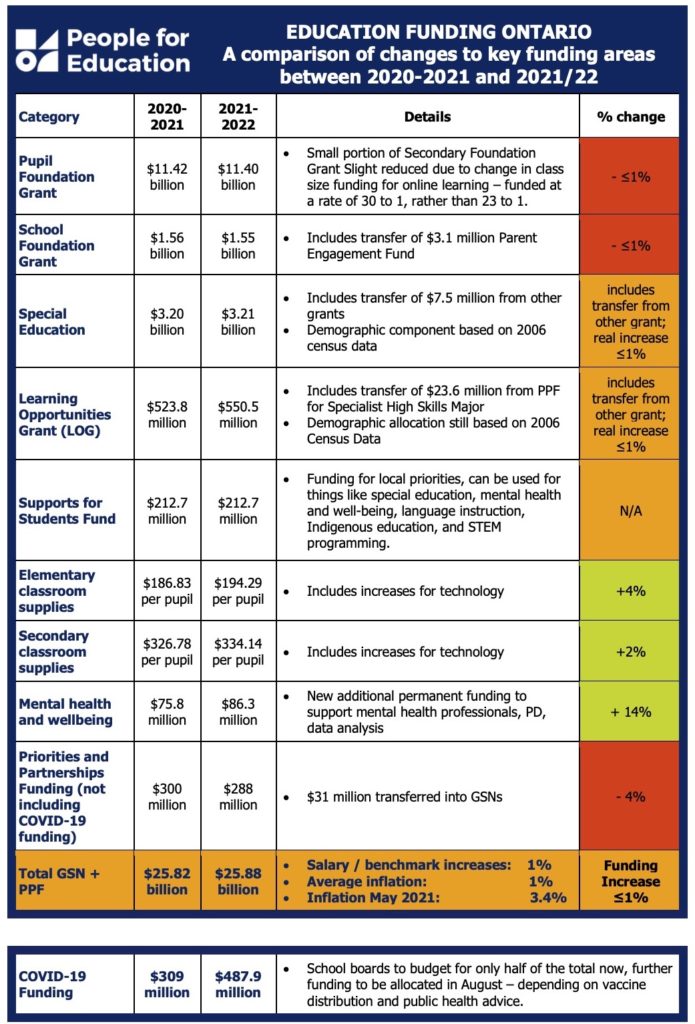Ontario’s Education Funding for the 2021-22 school year
For the coming school year, the total amount in Ontario’s Grants for Student Needs (GSNs) – which makes up the majority of school boards’ funding – has increased by less than 1%. This will not offset a combination of inflation plus salary increases mandated in contracts.
School boards also receive some funding through Priorities and Partnerships Funding (PPF) which is targeted to support specific programs and based partly on per pupil numbers and partly on boards’ applications. The base amount in the PPF also decreased (see table below), but the Ministry of Education has committed to provide extra funding through the PPF for the coming year to address COVID-related issues.
School boards promised funding for COVID supports for at least half the year
The Ministry of Education has committed $487.9 to fund COVID-related needs for the coming year. Boards have been told they are assured of receiving at least half of the funding now, with the situation to be re-evaluated and further funding to be allocated in August – depending on vaccine distribution and public health advice.
For the most part, this additional funding will be provided on a per pupil and per board basis. It includes:
- $304 million for staff (teachers, early childhood educators, educational assistants, custodians, school-based administrative support, principals and vice-principals) to facilitate smaller cohorts, physical distancing, enhanced cleaning and the delivery of remote learning (granted at a rate of $600,000 per board plus an allocation per pupil)
- $65.5 million for enhanced cleaning protocols and other health and safety measures in student transportation
- $49 million for special education, mental health and well-being and equity initiatives.
- $29.4 million for increased costs related to school operations in recognition of the need to operate ventilation systems longer and replace filters more frequently.
- $20 million for re-engaging students and reading assessment supports. (Funding will be allocated at a rate of $20,000 per school board, plus an amount per pupil)
- $20 million in connectivity supports for remote learning technology.
School Board may use reserves and run deficits
Both last year and this year, the Ministry of Education has stated that boards may access additional funding by using their reserves and running small deficits.
Boards and others have raised concerns that this is neither an equitable nor a sustainable solution. The amounts in boards’ reserves – if they have them at all – range widely, and boards point out that these reserves have been put aside over a number of years to fund planned larger projects.
Normally, boards are not allowed to run deficits, but in the coming school year, as in last year, the Ministry is allowing boards to run an in-year deficit of up to 2% of their operating allocation.
Boards will receive some top-up funding to reimburse them for a portion of this spending in one of two forms:
- Stabilization funding will compensate boards that did not have sufficient reserves to fund a 2% deficit. They will receive half of this funding for the first half of the school year, with the second 1% to be allocated in the fall depending on the status of public health and vaccinations.
- Supplemental funding will compensate boards for up to 2% of funding that they used from their reserves to cover the costs of COVD-19 related expenses. Again, this funding will be provided half now, and half in the fall depending on public health and vaccination circumstances.
Planning for the coming school year
The Ontario Public School Boards’ Association (OPSBA) has released a discussion paper –Transitioning from the COVID-19 School Experience – that outlines key issues to be addressed in the coming year(s). The OPSBA paper along with research from Ontario scholars points to a need for a significant increase in resources in the coming school year. Resources are needed not only to support students’ educational and psychological recovery from the pandemic, but also to address systemic inequities the pandemic exposed and exacerbated.
This is a rare once-in-a-lifetime chance to reset how Ontario provides education, a critical moment that needs everyone’s voice – students, educators, parents, trustees, everyone in our school communities.
OPSBA, Transitioning from the COVID-19 School Experience
In a letter to the Premier, Ontario’s COVID-19 Science Table, pointed to the need for investments to address COVID-related issues in the coming school year including things like improved ventilation in school buildings and strategies to address the long-term mental health, health and educational issues that students will be facing as a result of COVID-related school closures.
The summer will provide an ideal time to make the whole school system even safer by continuing to improve ventilation in school buildings and by vaccinating students. Moreover, Ontario should now start developing recovery plans to address the long-term mental health, health and educational problems arising from COVID-19-related school closures. This will require investments.
Ontario Science Table
The process to develop appropriate funding for these reforms should begin now, and should involve experts and practitioners from multiple sectors in an Education Advisory Task Force.
This is not the time to simply go back to what was done previously, but to challenge our collective selves to reimagine what schools could become to ensure that each and every student in our care thrives in school and in life.
OPSBA

